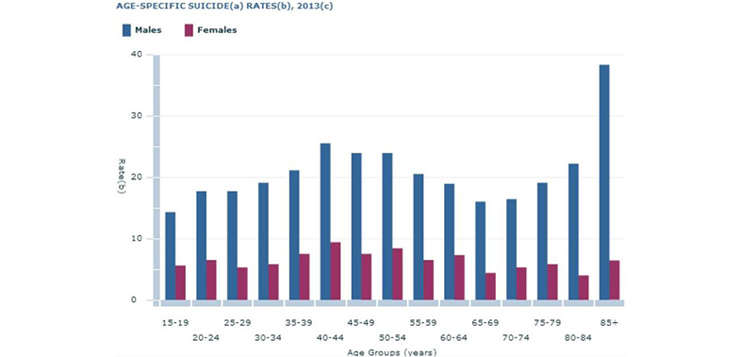The suicide rate for men 85 plus is 37.6 per 100,000 people, compared to 20.6 for men aged 20-24 and 29.9 for those aged 40-44. That’s 75% more than younger men.
And ABS figures show the number of suicides for the 85+ has jumped 15% between 2010 and 2014 to 2864 a year.
Research by the Australian Institute for Suicide Research and Prevention also shows suicidal behaviour for older people is often undertaken with “greater intent” and “more lethal methods” than younger people – what drives our older men to do it?
Depression not a “normal” part of getting older
The sad truth is there is a common misconception depression is a normal part of ageing for the elderly. Someone loses a spouse or child, moves into aged care or is caring for a sick partner and we assume it’s “natural” for them to feel sad or depressed.
In a submission to a Senate inquiry into suicide in Australia in 2009, Professor Brian Draper said suicide in old age remained a neglected topic[1].
But in fact, studies have found depression usually declines with age. However, many older sufferers often go undiagnosed and untreated because signs of depression, such as withdrawing from daily life, behaving out of character or being agitated or worried, are ignored.
It’s also frequently written off as a form of “euthanasia” when only 10% of late-life suicides cases would have met the generally accepted criteria for euthanasia, such as being the member of a euthanasia group[2].
Loneliness and illness among major factors
Another mistaken belief is only people suffering from mental illness have suicidal thoughts. This is not always the case. Older adults who committed suicide have actually been proven to be less likely to suffer from psychiatric disorders (62%) compared to middle-aged suicide cases (80%)[3].
Instead, Prof Draper said the lead-up to a suicide attempt in old age frequently involved “…declining health including chronic pain, in combination with social isolation, lack of social support, and evolving depression and hopelessness”. Living alone is a major factor.
Physical diseases such as chronic pain and cancer also play a role. Earlier this year, Queensland deputy state coroner John Lock called for more to be done to recognise the increased suicide risk caused by serious illness, following the suicide of a 75-year-old cancer patient living in an aged care home.
He recommended closer observation and suicide prevention programs for elderly people diagnosed with serious diseases following their diagnosis or treatment.
Know the warning signs
Suicide prevention often focuses on the youth and the middle-aged and forgets the elderly. But with elderly people less likely to discuss their plans prior to death[4], it’s important for family, aged care staff and healthcare providers to educate themselves on the warning signs.
Raylee Taylor, Chair of the Care For Life Suicide Prevention Network says “The aged may make comments about suicide but might not be taken seriously by their loved ones.”
HealthDirect has a comprehensive list of warning signs listed on their website here.
If you need help, please contact one of the organisations below:
Lifeline 13 11 14
MensLine Australia 1300 78 99 78
beyondblue 1300 22 4636
R U OK? Day is September 8.
[1] ‘Submission to the Senate Community Affairs References Committee: Inquiry into Suicide in Australia’ – November 2009
[2] ‘Suicides in older adults: A case-control psychological autopsy study in Australia’ – Journal of Psychiatric Research July 2013
[3] ‘Suicides in older adults: A case-control psychological autopsy study in Australia’ – Journal of Psychiatric Research July 2013
[4] Australian Institute for Suicide Research and Prevention



